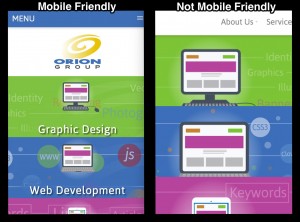 With last month’s release of Google’s new ranking algorithm that lowers non-mobile-friendly websites in a mobile search, people have been running to get their site mobile-friendly. But for those out there who have yet to make the switch, the options for turning a website “mobile-friendly” can be confusing and frustrating, especially for those who aren’t familiar with web design terms.
With last month’s release of Google’s new ranking algorithm that lowers non-mobile-friendly websites in a mobile search, people have been running to get their site mobile-friendly. But for those out there who have yet to make the switch, the options for turning a website “mobile-friendly” can be confusing and frustrating, especially for those who aren’t familiar with web design terms.
What are “mobile-friendly” websites?
Simply put, they are easily viewed on a phone and there’s no need to zoom in or scroll from side to side to read content. The image in this post is an example of what our website looks like on a phone, and what it might look like if it wasn’t mobile-friendly. There’s no logo, no text, and only part of the menu showing – not good.
What are the options making websites “mobile-friendly”?
The most popular two options are separate mobile sites (like m.yourdomain.com or yourdomain.com/mobile) and responsive sites (layouts that shift to fit the screen). There are pros and cons for each, but at Orion Group, our web developers recommend responsive sites for several reasons.
Mobile Website
- A separate domain and website specifically for mobile which can require more configuration and hosting.
- Potential duplicate content issue which can hurt Google rankings.
- Managing two separate websites which requires time and/or money.
Responsive Website
- One website which shifts to fit a screen of any size
- Businesses only have to manage one site
- Google only sees one set of pages
- At Orion Group, this is less expensive since it doesn’t require the creation of two websites
For more information on how responsive design works, you can visit our post: What does Responsive Web Design mean?
No matter what you choose, make sure you make the switch to mobile-friendly today before your website loses valuable traffic and you lose potential revenue. If you have questions regarding “Mobilegeddon” or you are unsure if your website is mobile-friendly, contact us today to speak with an expert.
